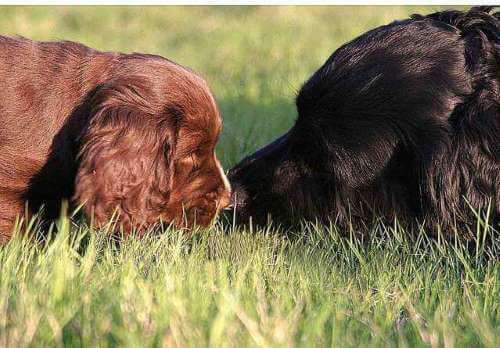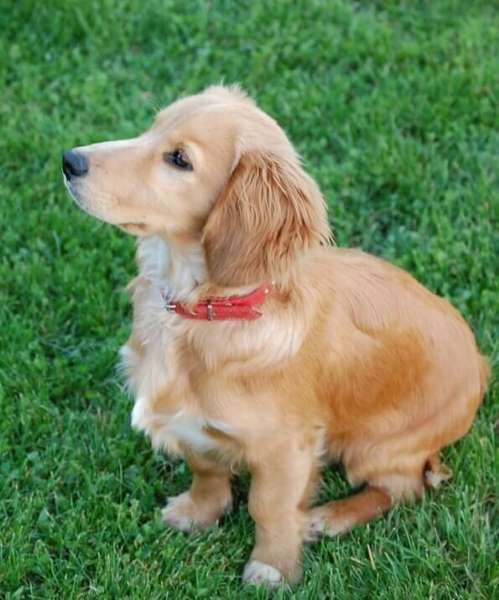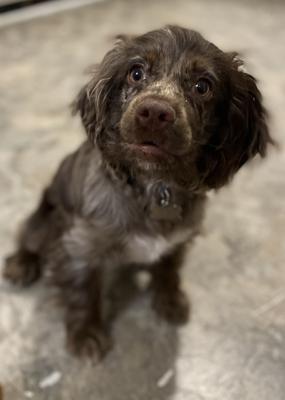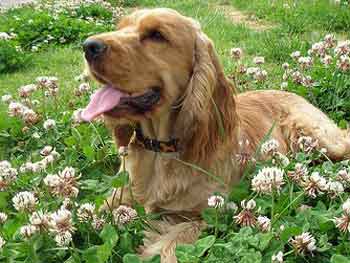- Home
- Cocker Spaniel Information
- A Potted History of Cocker Spaniels
The Cocker Spaniel History
You're here because you want to know more about the Cocker Spaniel history.
You'll find all you need to know about their origins, including information about the Cocker breed, their temperament and characteristics and the controversial tradition of tail docking. Read on...
The Cocker Spaniel History Goes Way Back!
The history of Cocker Spaniels is a little fuzzy, but it can be traced as far back as the 14th century.
It's said that the breed originated in Spain as hunting dogs and that the term 'Spaniel' comes from the French word for Spanish (Espagnol).
All spaniel breeds are said to be descended from this ancient, original dog breed.
They were very popular with hunters because they were eager little dogs, full of energy, and because of their compactness, they could easily flush out and retrieve game and birds...in fact, anything that moved!
 Cocker Spaniel History Goes Way Back
Cocker Spaniel History Goes Way BackPreviously No Formal Classification
Once upon a time, there was no formal classification between the different spaniel breeds; they were all known simply as 'Spaniels', sometimes also misspelt as 'Spanials'.
All spaniel breeds are descended from this very old, original dog breed.
They were very popular with hunters because they were eager, energetic dogs and could easily flush out and retrieve game and birds...in fact, anything that moved!
Emerging Breeds of Spaniels
During the 17th century, various Spaniel breeds began to emerge in Western Europe.
Although the work of flushing and retrieving was similar, the hunting landscape and type of animals hunted differed depending on the region, which eventually led to a need for different characteristics in the dogs.
Initially, puppies from the same litter would be separated by size and weight and given their 'jobs' accordingly.
Cockers
The smallest puppies in the litter would be chosen to use (when older) for scrambling through shrubs and the undergrowth to flush and retrieve woodcock. This is where the Cocker Spaniel got its name.
Springers
The largest of the litter would be used to spring birds and small game, and, you guessed it, that's where the term springer spaniel comes from.
Formal Classification for Spaniel Breeds
As the need for different characteristics in hunting dogs became more apparent, the best Spaniels were bred to create puppies that better suited their environment.
This is where the 'split' begins, from field or springer spaniel to Cocker Spaniel.
Unfortunately, the characteristics of these puppies were often inconsistent, and in 1885 the Spaniel Club formalised breed standards to help identify the differences.
The American Spaniel Club was established in 1881 but did not formally recognise the English Cocker Spaniel until September 1946.
In 1892 the Kennel Club formally recognised the Cocker Spaniel and introduced a formal weight classification:
- Dogs under 25 lbs were classified as Cockers because they were ideal for flushing out woodcock in low, dense woodland and thick undergrowth.
- Those over 25 lbs were classified as Springer Spaniels or Field Spaniels because they were very efficient at springing game.
The Cocker Spaniel Club was formed in 1902, and its aim was to promote the welfare of the Cocker and to encourage breeders to breed their puppies to a common standard.
While we recognise many varieties of Spaniels, this website focuses on the English Cocker Spaniel and its American cousin.
Cocker Spaniel Colours
The Cocker coat is classed as medium to long. Their fur can be either straight or slightly wavy, sometimes curly in places, and it's very soft and enjoyable to stroke.
A Cocker puppy won't have feathers, but they will grow as he ages. Feathers develop on the Cocker's legs, chest and tummy.
Their coats can be seen in many different colours, primarily golden, red, black and chocolate (also known as liver). There are also parti-colours, tri-colours, and roans.
If you want to know more about coat colours, follow the link.
Tail Docking: Love It Or Hate It?
Historically, Cocker Spaniels used to have their tails automatically docked, usually when they were between three and seven days old.
 What a lovely little puppy!
What a lovely little puppy!Docking is a 'simple' procedure where the puppy's tail is shortened to a small stump; usually, one-third to one-half of its tail would be removed.
This small operation would often be carried out by the breeder or the vet, and it was usually done without anaesthetic!
The original reason for docking was that tails often became damaged during a hunt and would subsequently need to be removed. It was only a short time before it became 'traditional' to automatically remove Cocker's tails.
Thankfully, this practice is now illegal in many countries. However, vets can remove a tail where they deem it necessary.
Max has a docked tail because the breeder felt it was traditional. She removed it just after he was born (because it was the norm) and days before the ban in the UK. I was unaware of this until it was too late; otherwise, I would have asked that the procedure wasn't done.
Personally, I prefer to see their tails left as they are; however, I love Max just the way he is!
The History of Cocker Spaniels
I hope this potted version of the history of Cocker Spaniels is enough to satisfy your curiosity.
However, if you're hungry to learn more about this beautiful breed, you can take a look at some of the titles below.
Discover the endearing characteristics and gentle temperament of today's Cocker Spaniel.
You'll soon see what all the fuss is about!
Photo Credit: Cocker Spaniel History
1. Rob Waterhouse - https://www.freeimages.com/photo/dibs-rocket-1387310
2. Stefan Hatvani - https://www.freeimages.com/photo/dog-3-1363102


